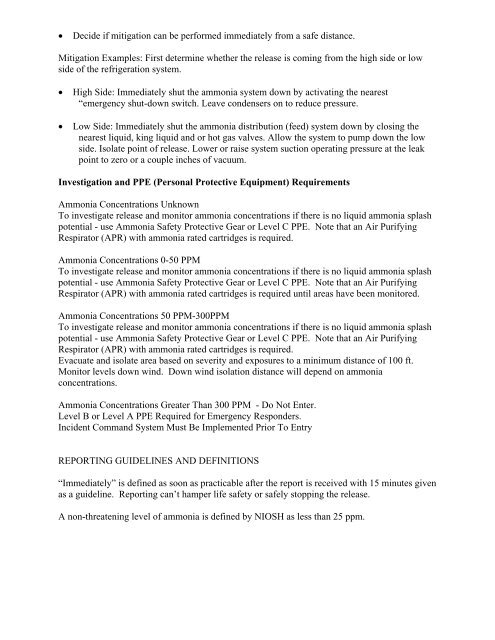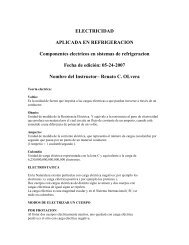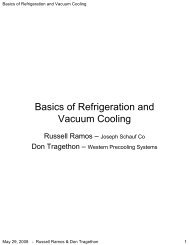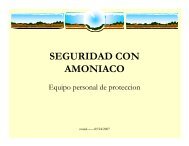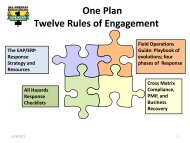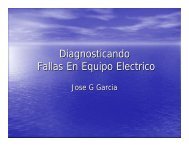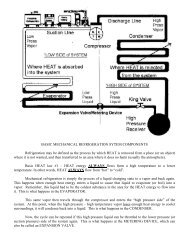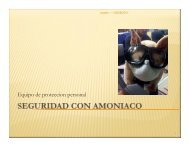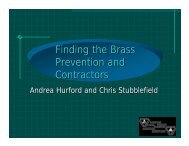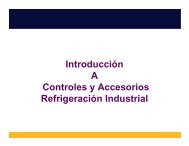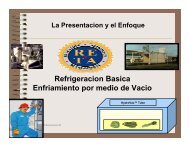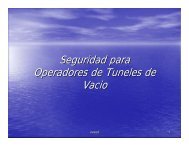AMMONIA RELEASE REPORTING GUIDELINES - Salinas Valley ...
AMMONIA RELEASE REPORTING GUIDELINES - Salinas Valley ...
AMMONIA RELEASE REPORTING GUIDELINES - Salinas Valley ...
Create successful ePaper yourself
Turn your PDF publications into a flip-book with our unique Google optimized e-Paper software.
• Decide if mitigation can be performed immediately from a safe distance.<br />
Mitigation Examples: First determine whether the release is coming from the high side or low<br />
side of the refrigeration system.<br />
• High Side: Immediately shut the ammonia system down by activating the nearest<br />
“emergency shut-down switch. Leave condensers on to reduce pressure.<br />
• Low Side: Immediately shut the ammonia distribution (feed) system down by closing the<br />
nearest liquid, king liquid and or hot gas valves. Allow the system to pump down the low<br />
side. Isolate point of release. Lower or raise system suction operating pressure at the leak<br />
point to zero or a couple inches of vacuum.<br />
Investigation and PPE (Personal Protective Equipment) Requirements<br />
Ammonia Concentrations Unknown<br />
To investigate release and monitor ammonia concentrations if there is no liquid ammonia splash<br />
potential - use Ammonia Safety Protective Gear or Level C PPE. Note that an Air Purifying<br />
Respirator (APR) with ammonia rated cartridges is required.<br />
Ammonia Concentrations 0-50 PPM<br />
To investigate release and monitor ammonia concentrations if there is no liquid ammonia splash<br />
potential - use Ammonia Safety Protective Gear or Level C PPE. Note that an Air Purifying<br />
Respirator (APR) with ammonia rated cartridges is required until areas have been monitored.<br />
Ammonia Concentrations 50 PPM-300PPM<br />
To investigate release and monitor ammonia concentrations if there is no liquid ammonia splash<br />
potential - use Ammonia Safety Protective Gear or Level C PPE. Note that an Air Purifying<br />
Respirator (APR) with ammonia rated cartridges is required.<br />
Evacuate and isolate area based on severity and exposures to a minimum distance of 100 ft.<br />
Monitor levels down wind. Down wind isolation distance will depend on ammonia<br />
concentrations.<br />
Ammonia Concentrations Greater Than 300 PPM - Do Not Enter.<br />
Level B or Level A PPE Required for Emergency Responders.<br />
Incident Command System Must Be Implemented Prior To Entry<br />
<strong>REPORTING</strong> <strong>GUIDELINES</strong> AND DEFINITIONS<br />
“Immediately” is defined as soon as practicable after the report is received with 15 minutes given<br />
as a guideline. Reporting can’t hamper life safety or safely stopping the release.<br />
A non-threatening level of ammonia is defined by NIOSH as less than 25 ppm.


